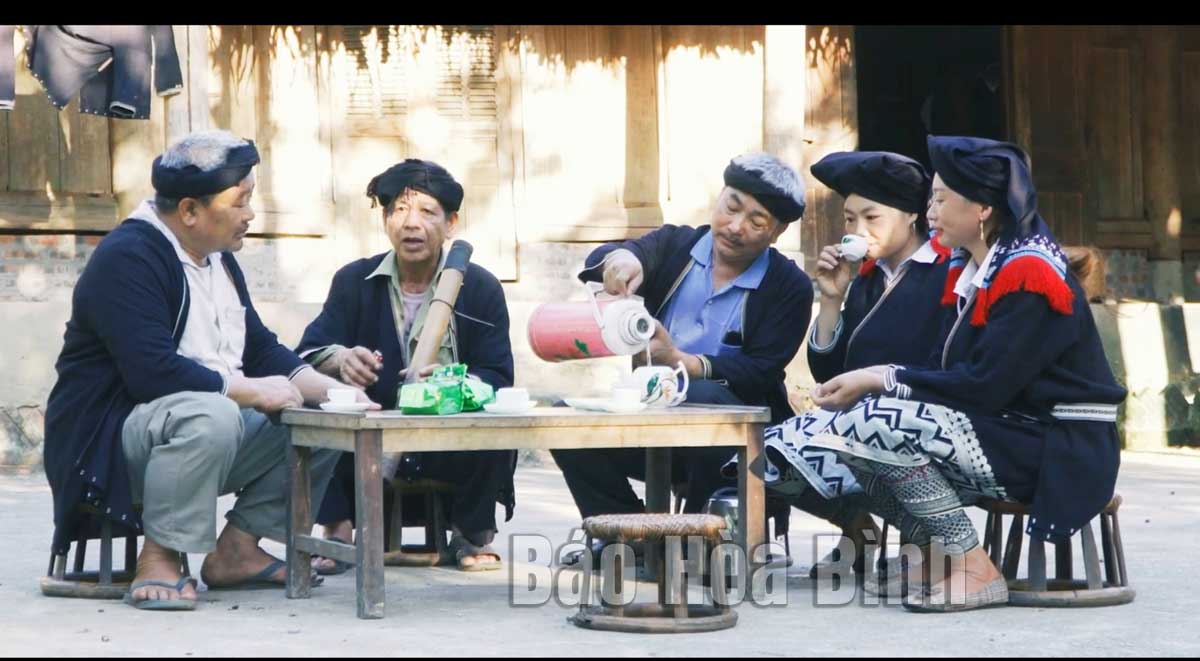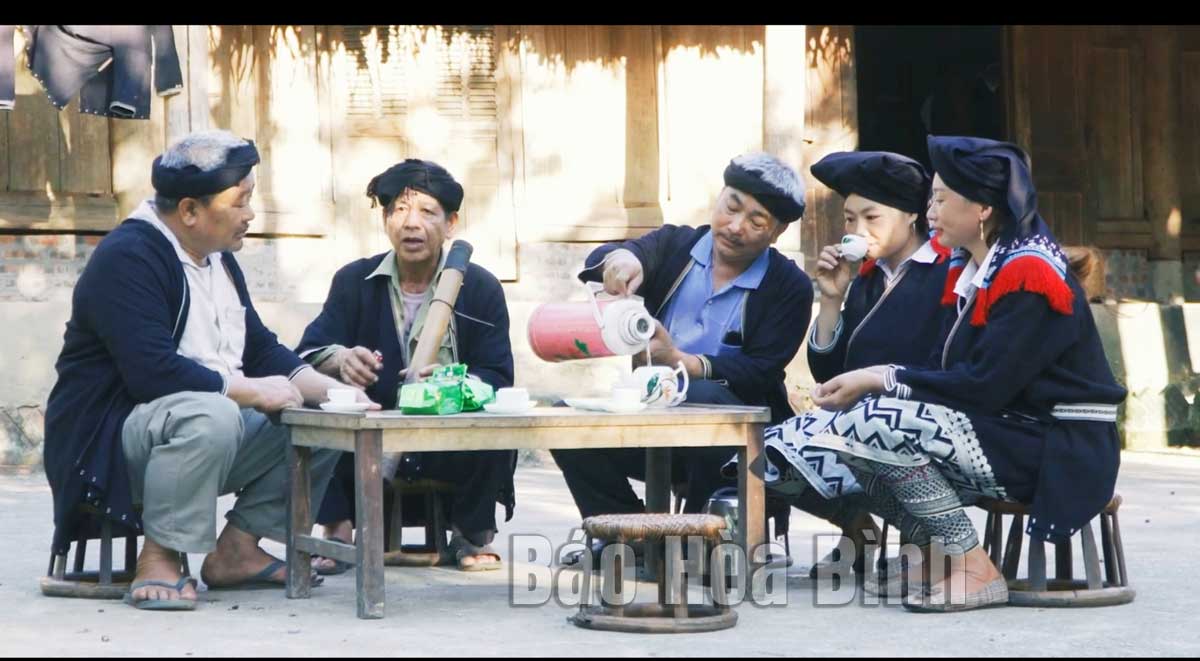



Trai cave in Tan Lap commune (Lac Son) is one of the relics that provide a lot of historical data about the human beings.
As the cradle of Muong culture, Hoa Binh has been inhabited since the prehistoric times. Trai cave in Tan Lap commune (Lac Son) is one of the relics that provide many vivid historical data about the human life. Here, the archaeologists have discovered the signs of kitchen ash and the skeletons aged over 14,000 - 17,000 years. Previously, during the excavations in the 80s of the last century, the researchers also found the scattered rice grains of the ancients, which were identified the ones during the Tran Dynasty. In addition, the remains of the tombs of the late Tran and early Le dynasties were found almost intactly. The primitive people in Hoa Binh Culture knew how to insert stone blocks and spread crushed stones around the graves to protect them. Also at Trai cave, the archaeologists found stone axes, animal bones, rice husks, walnut shells and many fossils of snail shells.
In 2001, Trai cave relics was recognized as the national archaeological relics. Visiting the relics on a warm sunny day, Trai mountain, which located in the middle of the rich Muong Vang field surrounded by Lan stream, appears in front of my eyes. Following the footsteps of the guides, I couldn't help but admire the layered snail shells, the fanciful rock fossils and even the patterns created by the ancients, imprinted over thousands of years of history. Mr. Bui Van Bang, the Secretary of the Party cell of Trai Sao hamlet, Tan Lap commune shares: Before being discovered by the scientists, Trai cave used to be a spiritual place. When knowing that this is a place inhabited by the prehistoric people and it was recognized as the national archaeological relics, the people in Trai Sao appreciate this mountain even more. From a primitive location, thanks to the attention of all levels and branches, Trai cave is now surrounded by fences, the path to the monument is built solidly, the local people have planted many trees to create a beautiful landscape. This is also a place that is planned to become one of the destinations serving tourists experiencing tourism in the land of Muong Vang.
Saying goog bye to Trai cave, we returned to the land of Muong Thang (Cao Phong). The place has the scenic beauty of the Dau Rong cave complex, which has been classified as the national monument by the Ministry of Culture, Sports and Tourism since 2012. In the distance, through the rooftops, Dau Rong Mountain appears to contain many interesting things as the landscape in the cave given to Muong land by the Creator happens to honor the cultural values that have been imprinted into the identity of Muong ethnic people for thousands of years. Da Rong range is more than 1km long with the heigt of nearly 200m above the foot of the mountain, stretching like a giant dragon, creating a town wall to the southeast of Cao Phong town. Inside there are beautiful caves linked together to form a shimmering and fanciful landscape complex with many shimmering stalactites. When visiting this place, visitors are definitely overwhelmed by the forest of glittering stalactites. Layer by layer, each layer of rocks evokes the image of a diligent Muong girl's feet going down to the field for the rice. Going deep into Hoa Son Thach Dong, there is a picture of all kinds of animals like a primeval forest in front of the eyes. There are stalactites that look like a coral block of the sea, lost in the highlands. Meeting the light of the wandering visitor, the pearl block flashes the magical lights.
Not only Hoa Son Thach Dong, the other caves such as Thanh Thuy, which is like a fairy tale about the eternal love of the couple; Nhan Long cave is like a monastery with countless Buddhas and Saints living in the spirit world; or Khong Day and Nuoc Caves have created a complex that is a complete work that captivates the people's hearts...
The sacred space and magical stalactites of Thac Bo cave are the interesting destinations for tourists on the journey to discover Thung Nai commune (Cao Phong).
Traveling around 4 Muong areas in Hoa Binh, in addition to meeting the gentle and friendly people, visitors can also explore the unique and impressive landscapes. They are Hang Nuoc and Thien Ton cave located in the heart of Nuoc and Mieu mountains – the 2 adjacent mountains in the complex of 99 mountains in Ngoc Luong commune (Yen Thuy); Man Nguyen cave in Thanh Cao commune (Luong Son) with many stalactites and beautiful scenes and mysterious shapes. Or Thac Bo cave in Bung hamlet, Suoi Hoa commune (Tan Lac) consists of 3 areas, in addition to the cave with stalactites, there is also a reception area for tourists, about 50 m high there is the area for worshiping Buddha; Mo Luong cave located in the Pu Kha mountain in Mai Chau town (Mai Chau) has many stalactites growing from the ground up with many shapes, creating the extremely vivid pictures...
Currently there are 556 relic sites in the whole province, including the revolutionary historical sites, the archaeological relics and the scenic relics which has been attracting many tourists such as Chua Tien cave complex (Lac Thuy), Nui Dau Rong cave complex (Cao Phong)... Contributing to conserving and promoting the value of the historical-cultural relics, the local authorities as well as the people have constantly made efforts and effectively implemented the propaganda and dissemination of the legal regulations for the regime, the policies, the management, the embellishment, promoting the values of historical - cultural relics, the scenic spots and the conservation and preservation in the area. At the same time, the Department of Culture, Sports and Tourism has also advised the Provincial People's Committee to issue the regulations on management, protection and promotion of the cultural heritage values in the province.
With the attention of all levels, branches, specialized units and the capital from the Program of the national enviroment on the cultural heritage preservation, many relics and scenic spots in the province have been embellished and restored. The restoration has been carried out seriously, under the management of the specialized agencies and according to the provisions of the Law on the Cultural Heritage. Thereby, many relics and beaty spots have become attractive tourism destinations after being restored and embellished, attracting many visitors inside and outside the province and contributing to the local socio-economic development...